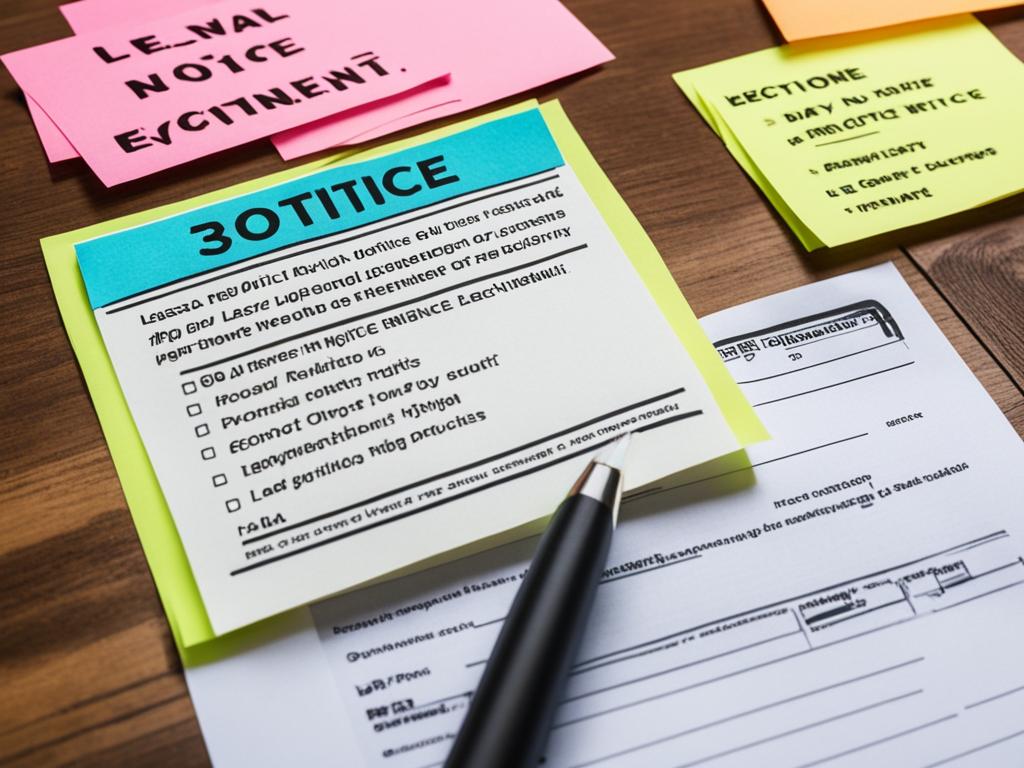Guide on How to Tell a Tenant to Move Out Nicely
When it comes to asking a tenant to move out, it’s important to approach the situation with kindness and professionalism to ensure a smooth transition for both the landlord and the tenant. This guide will provide effective strategies and tips for communicating with tenants about moving out in a respectful and polite manner.
Key Takeaways:
- Choose your words carefully and be considerate of the tenant’s feelings.
- Provide clear reasons and establish open lines of communication.
- Offer alternatives or resources to help the tenant in their transition.
- Follow legal procedures and consult with a lawyer if necessary.
- Maintain professionalism and respect throughout the process.
The Importance of a Move-Out Letter
A move-out letter is a crucial document that serves as a formal memo from the landlord to the tenant. It outlines the move-out procedure and sets clear expectations for both parties involved. It is important to note that a move-out letter is distinct from an eviction notice, which is a court-ordered removal.
Key Purposes of a Move-Out Letter:
- Complying with Legal Requirements: A move-out letter ensures that the landlord adheres to legal obligations in notifying the tenant of their need to vacate the property within the specified time frame.
- Providing Clarity: The letter clearly communicates the necessary steps and guidelines for the tenant to follow during the move-out process, such as cleaning requirements, returning keys, and inspection procedures.
- Creating a Documentation Record: A move-out letter serves as a written record of the communication between the landlord and tenant, reducing the possibility of misunderstandings or disputes later on.
- Ensuring the Return of the Security Deposit: By outlining the tenant’s obligations regarding the return of the security deposit, the move-out letter helps minimize any conflicts over deposit deductions.
- Maintaining Professionalism: The formal nature of a move-out letter demonstrates professionalism and helps preserve a positive landlord-tenant relationship, which can be beneficial for both parties.
- Specifying Timing: The letter establishes the specific move-out date and any applicable deadlines, ensuring that all parties are aware of the timeline for vacating the property.
- Facilitating Planning and Communication: A move-out letter enables both the landlord and tenant to plan for the future, whether it be finding a new tenant, scheduling repairs, or searching for a new rental property.
Overall, the move-out letter plays a vital role in maintaining transparency, minimizing conflicts, and upholding the landlord-tenant relationship during the process of transitioning from one tenancy to another.
Next, we’ll delve into the process of crafting a professional move-out letter, including important elements to include and how to ensure compliance with legal requirements.
Crafting a Professional Move-Out Letter
When it comes to ending a tenancy, providing a clear and formal move-out notice is crucial for both landlords and tenants. Crafting a professional move-out letter ensures that all parties involved have a thorough understanding of the expectations and responsibilities during this process. By including key elements in the letter, such as the notification date, move-out date, lease agreement title and date, reasons for moving out, day of the final walkthrough, and the name and signature of both parties, you can effectively communicate important details and maintain a professional approach.
It’s also important for landlords to familiarize themselves with the local laws and regulations regarding move-out notices to ensure compliance with the required notice periods. Each state or municipality may have specific guidelines, so be sure to review the local laws to avoid any legal issues. Additionally, carefully referencing the lease agreement in your move-out notice letter helps emphasize the tenant’s obligations and provides a framework for the termination process.
By prioritizing attention to detail and compliance with legal requirements, you can create a move-out notice letter that reflects your professionalism and adherence to local laws, ultimately facilitating a smooth and respectful transition for both parties involved.
Legal Requirements and Templates for Move-Out Letters
As a landlord, it is essential to adhere to the legal requirements and regulations that govern the move-out process. These requirements may vary depending on your state and the specific terms outlined in your lease agreement. By understanding and complying with these legal obligations, you can ensure a smooth and compliant transition for both yourself and your tenants.
When it comes to providing notice to vacate and terminating a tenancy, different states may have different notice periods and requirements. Familiarize yourself with the specific regulations in your jurisdiction and consult legal professionals or your lease agreement for guidance on the appropriate notice period.
A move-out letter, also known as a lease termination letter, is an important document that formalizes the tenant’s intention to vacate the premises and outlines the necessary steps for both parties. It serves as a written record of the termination of the tenancy and can be useful in resolving any disputes that may arise in the future.
To ensure compliance with legal requirements, consider including the following elements in your move-out letter:
- The date of the notice, clearly indicating when the letter was issued.
- The move-out date, specifying when the tenant is expected to vacate the premises.
- A reference to the lease agreement title and date, reaffirming the contractual obligations.
- The reason for the termination, providing clarity on the circumstances surrounding the move-out.
- The date of the final walkthrough, allowing both parties to inspect the property and address any issues.
- The name and signature of both the landlord and the tenant, acknowledging their agreement on the termination.
To simplify the process of creating a move-out letter, customizable templates are available. These templates can be tailored to fit your specific requirements and ensure that you include all the necessary information.
| Advantages of Using Templates for Move-Out Letters |
|---|
|
Using customizable templates not only saves time and ensures compliance but also allows you to maintain a consistent and professional approach when communicating with your tenants.
By understanding and adhering to the legal requirements for move-out letters and utilizing customizable templates, you can effectively navigate the move-out process while safeguarding your rights as a landlord and maintaining a positive landlord-tenant relationship.

Handling Special Circumstances
There may be situations where tenants need to terminate their lease early, face medical issues, or are deployed for military service. These special circumstances require understanding and flexibility from both landlords and tenants. It is crucial to maintain open and respectful dialogue and work together to find fair and amicable resolutions.
Early Lease Termination
Early lease termination can occur due to various reasons such as job relocations, changes in personal circumstances, or the need for a larger or smaller living space. As a landlord, it is important to approach these situations with empathy and understanding.
“[Your Name], I understand that you need to terminate your lease early due to unexpected circumstances. Let’s discuss the options available to ensure a smooth transition for both parties. Please provide formal written documentation supporting your request so that we can review it together.” – Example of respectful and open dialogue.
Medical Issues
When tenants experience medical issues that require them to move or make changes to their living arrangement, it is important to show compassion and support. Landlords should maintain open communication to understand the situation and find a suitable resolution.
“[Your Name], I’m sorry to hear about your medical issues. Let’s work together to explore solutions that accommodate your needs. Please provide any documentation from your healthcare provider that can help us find the best course of action.” – Example of empathetic and supportive response.
Military Deployment
Servicemembers may face military deployment or transfer, which may require them to move out of their rental property. Landlords should acknowledge their service and be flexible in accommodating their needs.
“[Your Name], thank you for your service to our country. I understand that military deployment requires you to relocate. Let’s discuss your options and ensure a smooth transition. Please provide formal written documentation confirming your deployment dates so that we can make the necessary arrangements.” – Example of appreciative and accommodating communication.
By approaching these special circumstances with empathy, open communication, and a willingness to find fair solutions, landlords can help tenants navigate challenging situations while maintaining a positive landlord-tenant relationship.
Importance of Communication and Tenant Move-Out Checklist
Effective communication is vital throughout the move-out process to maintain a positive landlord-tenant relationship. By keeping the lines of communication open and clear, both parties can ensure a smooth and fair transition at the end of the lease agreement. Additionally, utilizing a tenant move-out checklist can help streamline the process and prevent any misunderstandings or oversights.
Notice and Communication
When it’s time for your tenant to move out, it’s important to provide them with proper notice in accordance with your local laws and the terms of the lease agreement. This notice should clearly outline the move-out date, any necessary instructions, and contact information for any questions or concerns. Maintaining open and responsive communication throughout this period will help address any issues promptly and ensure a smoother transition.
Review Lease Agreement
Before your tenant moves out, both parties should review the lease agreement to refresh their memory on the specific terms and obligations. This ensures that everyone is on the same page regarding matters such as cleaning expectations, repairs, and the return of the security deposit. By familiarizing yourself with the lease agreement, you can address any potential areas of concern and prevent any disputes that may arise.
Preparing the Property
Prior to the tenant’s move-out date, it’s crucial to prepare the property for the next tenant. This involves conducting a thorough inspection to identify any necessary repairs or maintenance tasks. It’s also important to remove any personal belongings left behind by the tenant and ensure that the property is clean and in good condition for the next occupant. Preparing the property in advance helps expedite the turnover process and minimizes any potential delays.
Cleaning and Repairs
Cleaning and making necessary repairs are key steps in ensuring that the property is in the best possible condition for the next tenant. This includes tasks such as deep cleaning the carpets, scrubbing the bathrooms, and touching up paint where necessary. By addressing any repairs or maintenance issues promptly, you can provide a well-maintained living space for the next occupant and uphold the reputation of your rental property.

Utilities and Services
As part of the move-out process, it’s important to inform utility companies and service providers of the tenant’s departure. This includes notifying them of the move-out date and scheduling the disconnection of utilities, such as electricity, gas, and water. By ensuring a smooth transition of these services, you can avoid any unnecessary expenses or complications for both the tenant and the landlord.
By placing a strong emphasis on communication and utilizing a comprehensive tenant move-out checklist, landlords can navigate the move-out process more efficiently and maintain a positive landlord-tenant relationship. Clear and open communication, along with proper preparation and adherence to the lease agreement, can help minimize disputes and ensure a successful transition for all parties involved.
Conclusion
Telling a tenant to move out nicely requires a thoughtful and considerate approach. By implementing effective strategies and maintaining open lines of communication with tenants, landlords can ensure a smoother transition while upholding a positive and respectful landlord-tenant relationship.
Throughout this guide, we have provided valuable tips and techniques for approaching the delicate task of asking a tenant to move out. By following these steps, landlords can navigate the process professionally and empathetically, minimizing potential conflicts and fostering a more harmonious experience for all parties involved.
Remember, it is important to craft a professional move-out letter that complies with legal requirements and clearly outlines the expectations for both the landlord and the tenant. By familiarizing yourself with local laws and utilizing customizable templates, you can ensure accuracy and meet all necessary obligations.
Effective communication, understanding special circumstances, and utilizing a tenant move-out checklist are crucial aspects of the process. By maintaining open dialogue, accommodating unique situations, and providing helpful resources, landlords can facilitate a smooth move-out process.
FAQ
What is a move-out letter and how is it different from an eviction notice?
A move-out letter is a formal memo from the landlord to the tenant, outlining the move-out procedure and expectations for both parties. It differs from an eviction notice, which is a court-ordered removal.
What are the purposes of a move-out letter?
A move-out letter serves several purposes, including complying with legal requirements, providing clarity, creating a documentation record, ensuring the return of the security deposit, maintaining professionalism, specifying timing, and facilitating planning and communication.
What key elements should be included in a move-out notice letter?
Key elements to include in a move-out notice letter are the notification date, move-out date, lease agreement title and date, reasons for moving out, day of final walkthrough, and name and signature of both parties.
What legal requirements should landlords be aware of when sending a move-out letter?
Landlords should familiarize themselves with state and local laws and their lease agreement to ensure compliance with required notice periods and any specific guidelines and requirements. Consulting with legal professionals is also advisable.
How should landlords handle special circumstances like early lease termination or medical issues?
Special circumstances may require flexibility and understanding. Landlords should maintain open and respectful dialogue, provide formal written documentation to support requests, and work together with tenants to find fair resolutions.
Why is communication important during the move-out process, and what should landlords include in a tenant move-out checklist?
Open and clear communication helps maintain a positive landlord-tenant relationship. A tenant move-out checklist can ensure a smooth transition and should include steps such as providing proper notice, reviewing the lease agreement, preparing the property, cleaning and making repairs, and notifying utility companies.
How can landlords approach the process of telling a tenant to move out nicely?
Landlords can approach the process professionally and empathetically by following effective strategies, maintaining open dialogue, and prioritizing a positive and respectful landlord-tenant relationship.

